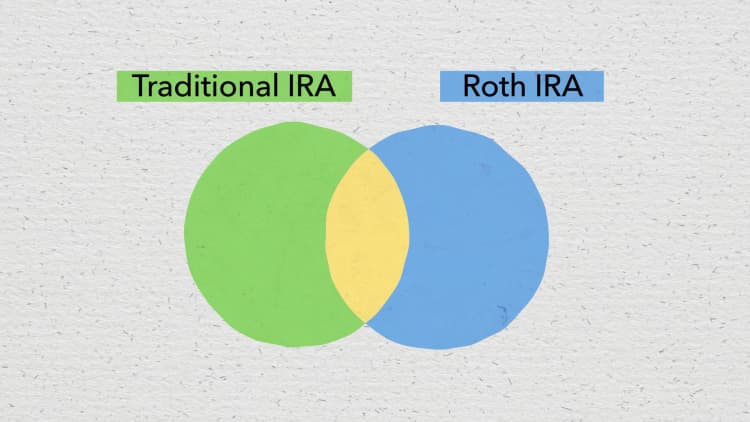Plummeting markets are making Roth IRAs more attractive, although not everyone can put money into these retirement accounts.
Workers can save after-tax dollars in these individual retirement accounts, have them grow tax-free and then tap them free of taxes in retirement.
Two events make Roths an even better deal today: First, falling stock prices mean you can buy more shares of stock or mutual funds at lower prices.
Second, individual income tax rates are low, thanks to the Tax Cuts and Jobs Act. This reduces the tax cost of contributing to the Roth IRA.
But there's a catch. This account isn't available to everyone.
For instance, singles with more than $124,000 in modified adjusted gross income ($196,000 for married filing jointly) in 2020 cannot contribute up to the limit — $6,000, plus $1,000 if over age 50.
Single households with MAGI of $139,000 and greater ($206,000 for married and filing jointly) can't save in a Roth IRA at all.
"If we're doing the return now, we see if we can get income down within a certain threshold," said Dan Herron, CPA and principal of Elemental Wealth Advisors in San Luis Obispo, California.
Here are a few ways to ramp up your tax-free retirement accounts.
1. Reduce your income
Review your 2019 tax return with your CPA or tax professional to plot out opportunities to shave a few bucks from your MAGI in 2020.
This might make the most sense if you're just slightly over the income threshold for making the Roth IRA contribution.
Increasing your 401(k) plan contributions at work can help you trim your MAGI, said Herron. In 2020, you can save up to $19,500 in your 401(k), plus $6,500 if aged 50 and over.
Plugging money into both your 401(k) and your Roth IRA also gives you the benefit of tax diversification in retirement.

It's best to have your savings in a combination of tax-free, taxable and tax-deferred accounts so you can manage your tax bracket in the future.
"I want our clients to have that income flexibility going forward, as opposed to putting all the eggs in one basket and having no maneuvering," said Herron.
Self-employed people also have additional levers to pull to reduce their MAGI.
They can take deductions for medical and dental insurance premiums and write-offs for depreciation of equipment, as well as for their retirement plan contributions.
2. Backdoor Roth conversion
Maybe your income is significantly higher than the threshold for making Roth contributions.
"For salaried employees, it can be tough to cut your adjusted gross income," said Ed Slott, CPA and president of Ed Slott & Co. in Rockville Centre, New York. "If you're set on that Roth IRA, do the backdoor Roth conversion."
This means, you would make a nondeductible contribution with after-tax money to a traditional IRA account and then convert it to a Roth. This conversion should be tax-free.
There are ways for backdoor Roth conversions to go wrong.

For instance, if you make a backdoor Roth conversion but you have other IRAs with pretax dollars in them, the IRS could hit you with income taxes based on the overall value of those accounts.
Those "other IRAs" include traditional IRAs, SEP and SIMPLE IRAs.
This is known as the pro rata rule.
Another way to get ensnared in the pro rata rule: You convert the nondeductible IRA, but then roll your 401(k) over into an IRA later that year.
That's because the pro rata rule considers your IRA balances at the end of the year.
3. Roth 401(k) — if you have one
In 2018, more than 7 out of 10 retirement plans offered by Vanguard had a Roth 401(k) feature, and 11% of participants chose the option.
Like Roth IRAs, Roth 401(k) plans allow you to put away after-tax dollars and have them accumulate tax-free so that you can tap them free of taxes in retirement.
There are a few key differences between the two. For starters, there's no income limitation to participate in a Roth 401(k).
Further, the IRS allows you to contribute in aggregate up to $19,500, plus $6,500 if you're over 50, to your traditional and Roth 401(k) plans.
More from Smart Tax Planning:
Where to get your tax return done for free
Treasury recommends Trump delay the April 15 tax deadline
Why your tax return may spark interest from the IRS
Finally, your Roth 401(k) is subject to required minimum distributions — mandated withdrawals you must take from the account starting at age 72.
In contrast, Roth IRA owners aren't required to draw down their account while they're alive.
Ramping up your contributions to this account might seem daunting when the market is in free fall, but it makes sense if you won't need the money for years and can withstand the volatility.
"Right now the funds you're investing in are getting cheaper, and you can buy more shares with the amount contributed," said Herron. "So when there's a recovery, you'll have more in savings."





